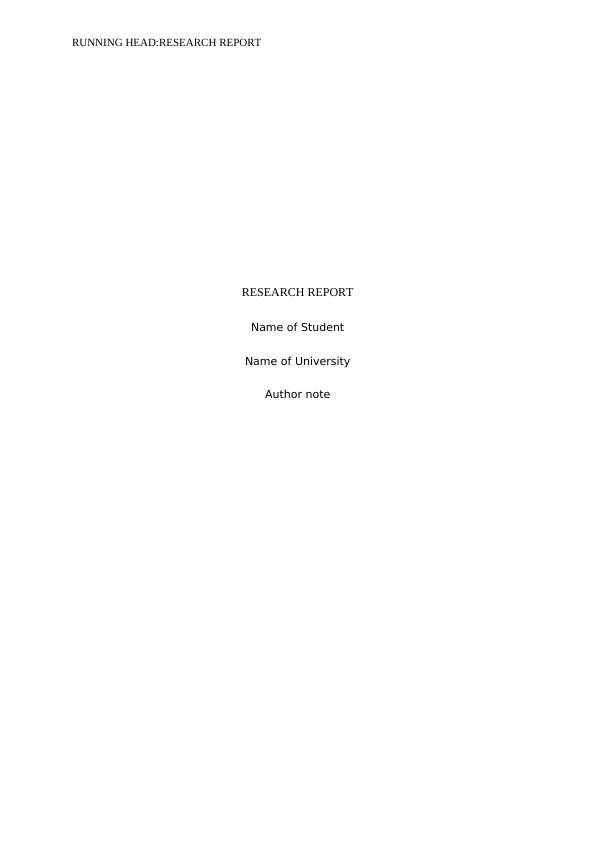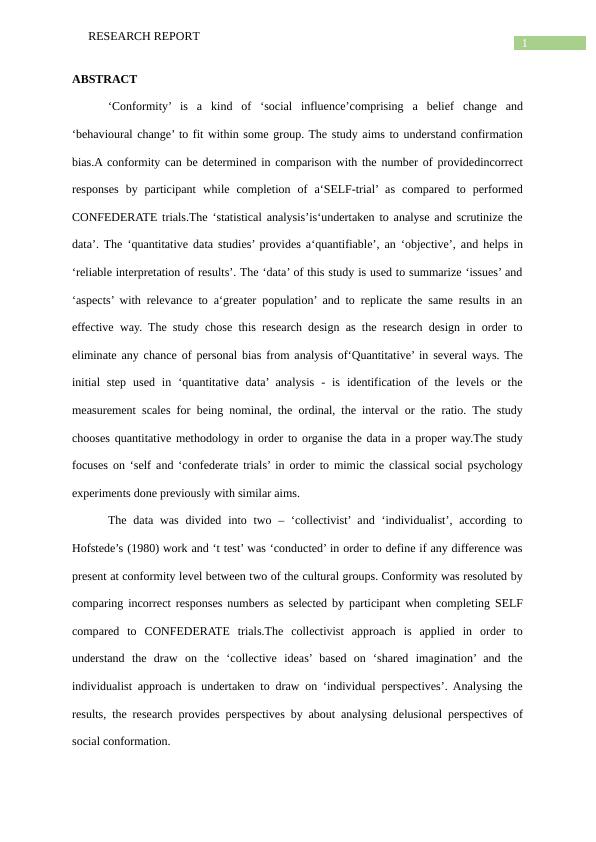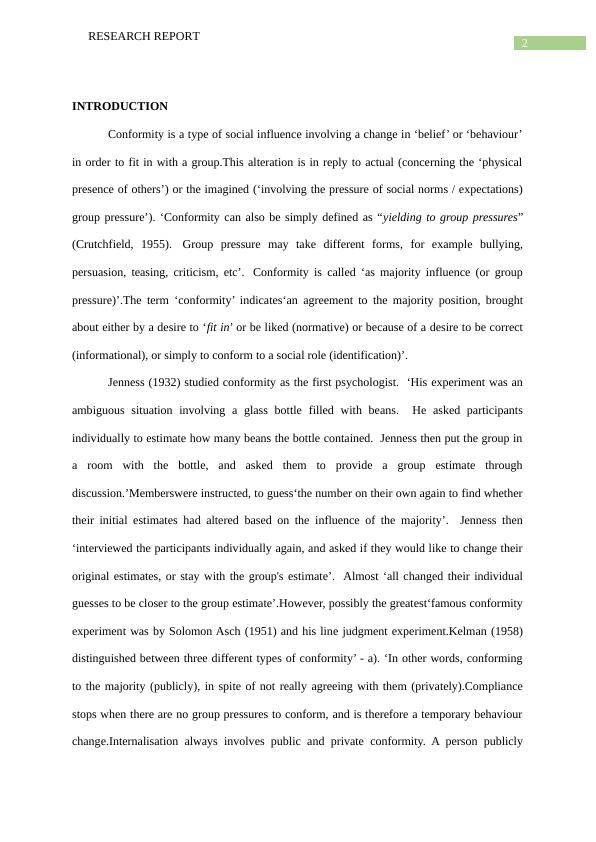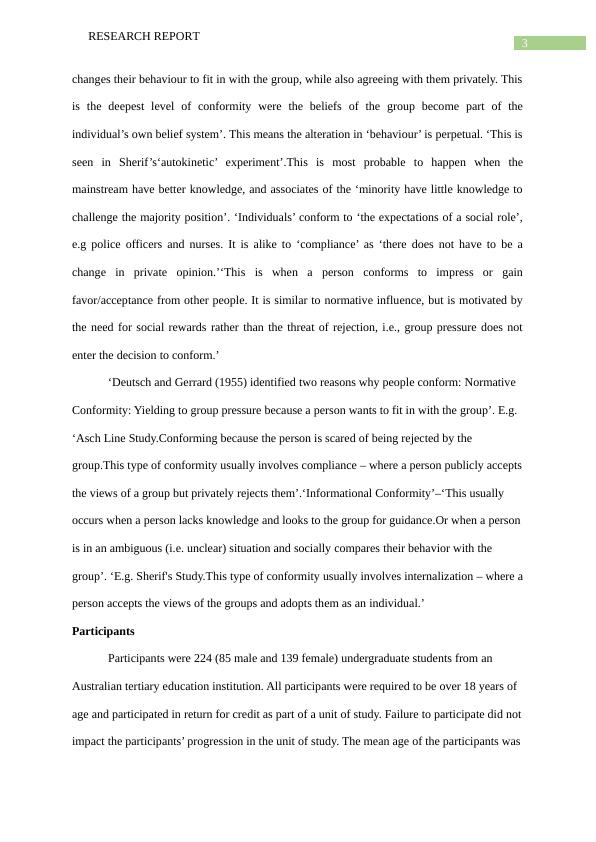Quantitative Research Report 2022
Added on 2022-10-15
11 Pages3124 Words16 Views
RUNNING HEAD:RESEARCH REPORT
RESEARCH REPORT
Name of Student
Name of University
Author note
RESEARCH REPORT
Name of Student
Name of University
Author note

1
RESEARCH REPORT
ABSTRACT
‘Conformity’ is a kind of ‘social influence’comprising a belief change and
‘behavioural change’ to fit within some group. The study aims to understand confirmation
bias.A conformity can be determined in comparison with the number of providedincorrect
responses by participant while completion of a‘SELF-trial’ as compared to performed
CONFEDERATE trials.The ‘statistical analysis’is‘undertaken to analyse and scrutinize the
data’. The ‘quantitative data studies’ provides a‘quantifiable’, an ‘objective’, and helps in
‘reliable interpretation of results’. The ‘data’ of this study is used to summarize ‘issues’ and
‘aspects’ with relevance to a‘greater population’ and to replicate the same results in an
effective way. The study chose this research design as the research design in order to
eliminate any chance of personal bias from analysis of‘Quantitative’ in several ways. The
initial step used in ‘quantitative data’ analysis - is identification of the levels or the
measurement scales for being nominal, the ordinal, the interval or the ratio. The study
chooses quantitative methodology in order to organise the data in a proper way.The study
focuses on ‘self and ‘confederate trials’ in order to mimic the classical social psychology
experiments done previously with similar aims.
The data was divided into two – ‘collectivist’ and ‘individualist’, according to
Hofstede’s (1980) work and ‘t test’ was ‘conducted’ in order to define if any difference was
present at conformity level between two of the cultural groups. Conformity was resoluted by
comparing incorrect responses numbers as selected by participant when completing SELF
compared to CONFEDERATE trials.The collectivist approach is applied in order to
understand the draw on the ‘collective ideas’ based on ‘shared imagination’ and the
individualist approach is undertaken to draw on ‘individual perspectives’. Analysing the
results, the research provides perspectives by about analysing delusional perspectives of
social conformation.
RESEARCH REPORT
ABSTRACT
‘Conformity’ is a kind of ‘social influence’comprising a belief change and
‘behavioural change’ to fit within some group. The study aims to understand confirmation
bias.A conformity can be determined in comparison with the number of providedincorrect
responses by participant while completion of a‘SELF-trial’ as compared to performed
CONFEDERATE trials.The ‘statistical analysis’is‘undertaken to analyse and scrutinize the
data’. The ‘quantitative data studies’ provides a‘quantifiable’, an ‘objective’, and helps in
‘reliable interpretation of results’. The ‘data’ of this study is used to summarize ‘issues’ and
‘aspects’ with relevance to a‘greater population’ and to replicate the same results in an
effective way. The study chose this research design as the research design in order to
eliminate any chance of personal bias from analysis of‘Quantitative’ in several ways. The
initial step used in ‘quantitative data’ analysis - is identification of the levels or the
measurement scales for being nominal, the ordinal, the interval or the ratio. The study
chooses quantitative methodology in order to organise the data in a proper way.The study
focuses on ‘self and ‘confederate trials’ in order to mimic the classical social psychology
experiments done previously with similar aims.
The data was divided into two – ‘collectivist’ and ‘individualist’, according to
Hofstede’s (1980) work and ‘t test’ was ‘conducted’ in order to define if any difference was
present at conformity level between two of the cultural groups. Conformity was resoluted by
comparing incorrect responses numbers as selected by participant when completing SELF
compared to CONFEDERATE trials.The collectivist approach is applied in order to
understand the draw on the ‘collective ideas’ based on ‘shared imagination’ and the
individualist approach is undertaken to draw on ‘individual perspectives’. Analysing the
results, the research provides perspectives by about analysing delusional perspectives of
social conformation.

2
RESEARCH REPORT
INTRODUCTION
Conformity is a type of social influence involving a change in ‘belief’ or ‘behaviour’
in order to fit in with a group.This alteration is in reply to actual (concerning the ‘physical
presence of others’) or the imagined (‘involving the pressure of social norms / expectations)
group pressure’). ‘Conformity can also be simply defined as “yielding to group pressures”
(Crutchfield, 1955). Group pressure may take different forms, for example bullying,
persuasion, teasing, criticism, etc’. Conformity is called ‘as majority influence (or group
pressure)’.The term ‘conformity’ indicates‘an agreement to the majority position, brought
about either by a desire to ‘fit in’ or be liked (normative) or because of a desire to be correct
(informational), or simply to conform to a social role (identification)’.
Jenness (1932) studied conformity as the first psychologist. ‘His experiment was an
ambiguous situation involving a glass bottle filled with beans. He asked participants
individually to estimate how many beans the bottle contained. Jenness then put the group in
a room with the bottle, and asked them to provide a group estimate through
discussion.’Memberswere instructed, to guess‘the number on their own again to find whether
their initial estimates had altered based on the influence of the majority’. Jenness then
‘interviewed the participants individually again, and asked if they would like to change their
original estimates, or stay with the group's estimate’. Almost ‘all changed their individual
guesses to be closer to the group estimate’.However, possibly the greatest‘famous conformity
experiment was by Solomon Asch (1951) and his line judgment experiment.Kelman (1958)
distinguished between three different types of conformity’ - a). ‘In other words, conforming
to the majority (publicly), in spite of not really agreeing with them (privately).Compliance
stops when there are no group pressures to conform, and is therefore a temporary behaviour
change.Internalisation always involves public and private conformity. A person publicly
RESEARCH REPORT
INTRODUCTION
Conformity is a type of social influence involving a change in ‘belief’ or ‘behaviour’
in order to fit in with a group.This alteration is in reply to actual (concerning the ‘physical
presence of others’) or the imagined (‘involving the pressure of social norms / expectations)
group pressure’). ‘Conformity can also be simply defined as “yielding to group pressures”
(Crutchfield, 1955). Group pressure may take different forms, for example bullying,
persuasion, teasing, criticism, etc’. Conformity is called ‘as majority influence (or group
pressure)’.The term ‘conformity’ indicates‘an agreement to the majority position, brought
about either by a desire to ‘fit in’ or be liked (normative) or because of a desire to be correct
(informational), or simply to conform to a social role (identification)’.
Jenness (1932) studied conformity as the first psychologist. ‘His experiment was an
ambiguous situation involving a glass bottle filled with beans. He asked participants
individually to estimate how many beans the bottle contained. Jenness then put the group in
a room with the bottle, and asked them to provide a group estimate through
discussion.’Memberswere instructed, to guess‘the number on their own again to find whether
their initial estimates had altered based on the influence of the majority’. Jenness then
‘interviewed the participants individually again, and asked if they would like to change their
original estimates, or stay with the group's estimate’. Almost ‘all changed their individual
guesses to be closer to the group estimate’.However, possibly the greatest‘famous conformity
experiment was by Solomon Asch (1951) and his line judgment experiment.Kelman (1958)
distinguished between three different types of conformity’ - a). ‘In other words, conforming
to the majority (publicly), in spite of not really agreeing with them (privately).Compliance
stops when there are no group pressures to conform, and is therefore a temporary behaviour
change.Internalisation always involves public and private conformity. A person publicly

3
RESEARCH REPORT
changes their behaviour to fit in with the group, while also agreeing with them privately. This
is the deepest level of conformity were the beliefs of the group become part of the
individual’s own belief system’. This means the alteration in ‘behaviour’ is perpetual. ‘This is
seen in Sherif’s‘autokinetic’ experiment’.This is most probable to happen when the
mainstream have better knowledge, and associates of the ‘minority have little knowledge to
challenge the majority position’. ‘Individuals’ conform to ‘the expectations of a social role’,
e.g police officers and nurses. It is alike to ‘compliance’ as ‘there does not have to be a
change in private opinion.’‘This is when a person conforms to impress or gain
favor/acceptance from other people. It is similar to normative influence, but is motivated by
the need for social rewards rather than the threat of rejection, i.e., group pressure does not
enter the decision to conform.’
‘Deutsch and Gerrard (1955) identified two reasons why people conform: Normative
Conformity: Yielding to group pressure because a person wants to fit in with the group’. E.g.
‘Asch Line Study.Conforming because the person is scared of being rejected by the
group.This type of conformity usually involves compliance – where a person publicly accepts
the views of a group but privately rejects them’.‘Informational Conformity’–‘This usually
occurs when a person lacks knowledge and looks to the group for guidance.Or when a person
is in an ambiguous (i.e. unclear) situation and socially compares their behavior with the
group’. ‘E.g. Sherif's Study.This type of conformity usually involves internalization – where a
person accepts the views of the groups and adopts them as an individual.’
Participants
Participants were 224 (85 male and 139 female) undergraduate students from an
Australian tertiary education institution. All participants were required to be over 18 years of
age and participated in return for credit as part of a unit of study. Failure to participate did not
impact the participants’ progression in the unit of study. The mean age of the participants was
RESEARCH REPORT
changes their behaviour to fit in with the group, while also agreeing with them privately. This
is the deepest level of conformity were the beliefs of the group become part of the
individual’s own belief system’. This means the alteration in ‘behaviour’ is perpetual. ‘This is
seen in Sherif’s‘autokinetic’ experiment’.This is most probable to happen when the
mainstream have better knowledge, and associates of the ‘minority have little knowledge to
challenge the majority position’. ‘Individuals’ conform to ‘the expectations of a social role’,
e.g police officers and nurses. It is alike to ‘compliance’ as ‘there does not have to be a
change in private opinion.’‘This is when a person conforms to impress or gain
favor/acceptance from other people. It is similar to normative influence, but is motivated by
the need for social rewards rather than the threat of rejection, i.e., group pressure does not
enter the decision to conform.’
‘Deutsch and Gerrard (1955) identified two reasons why people conform: Normative
Conformity: Yielding to group pressure because a person wants to fit in with the group’. E.g.
‘Asch Line Study.Conforming because the person is scared of being rejected by the
group.This type of conformity usually involves compliance – where a person publicly accepts
the views of a group but privately rejects them’.‘Informational Conformity’–‘This usually
occurs when a person lacks knowledge and looks to the group for guidance.Or when a person
is in an ambiguous (i.e. unclear) situation and socially compares their behavior with the
group’. ‘E.g. Sherif's Study.This type of conformity usually involves internalization – where a
person accepts the views of the groups and adopts them as an individual.’
Participants
Participants were 224 (85 male and 139 female) undergraduate students from an
Australian tertiary education institution. All participants were required to be over 18 years of
age and participated in return for credit as part of a unit of study. Failure to participate did not
impact the participants’ progression in the unit of study. The mean age of the participants was

End of preview
Want to access all the pages? Upload your documents or become a member.